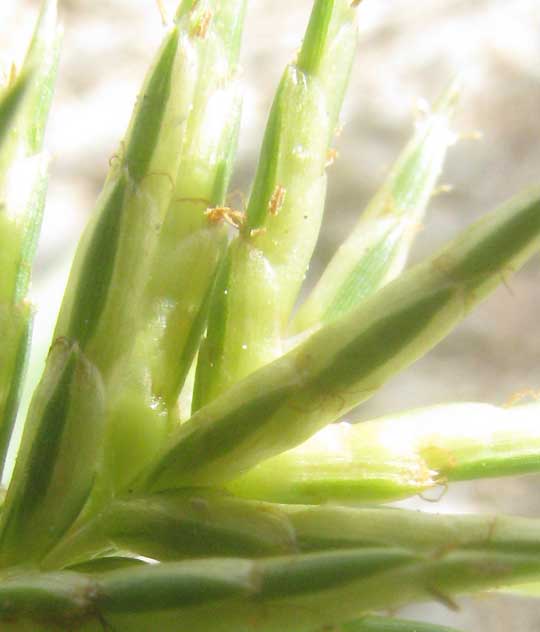Excerpts from Jim Conrad's
Naturalist Newsletter

from the September 22, 2013 Newsletter issued from the Frio Canyon Nature Education Center in the valley of the Dry Frio River in northern Uvalde County, southwestern Texas, on the southern border of the Edwards Plateau; elevation ~1750m (~5750 ft); N29.62°, W99.86°; USA
RUSTY FLATSEDGE
In hot sunlight glaring off white limestone gravel in the dried-up bed of the little Dry Frio River, at least one plant species was able to take root and prosper. The achievement was made easier by its location right where water seeps from the gravel into a depression to form a pool, when there's water to seep and a pool to form, which here wasn't the case. Still, the plant seemed to thrive, and you can see above.
With grass-like leaves arising at the stems' bases, and each otherwise leafless stem topped with broad, leaf-like inflorescence bracts, and slender flower spikelets forming such bushy inflorescences above the leaves, anyone halfway familiar with mud-loving plants recognizes this as a kind of flatsedge, sometimes known as nutsedges, umbrella-sedges or galingales -- genus Cyperus of the Sedge Family, the Cyperaceae. Papyrus is a Cyperus looking somewhat like this, though much larger, and so is Chufa, planted in gardens for their tubers. Our plant was only about six inches tall (15cm). About 600 Cyperus species are recognized, of which some 96 occur in North America, so which was this one?
A shot from the side better showing how the inflorescences of slender spikelets are subtended by leaf-like bracts is shown below:

A close-up of slender spikelets with anthers and styles emerging from behind green-ribbed scales with pale margins is below:

This is a common and widely distributed species, a good one to know. Commonly it's called the Rusty or Fragrant Flatsedge. It's CYPERUS ODORATUS, occurring in wet, muddy areas, including disturbed and altered sites, in much of the world's tropical and warm regions. This is one of those few species that's so adaptive and flexible that it's found in warm, moist areas nearly worldwide.
In our area no other Cyperus species produces so many very slender, densely clustered spikelets that are round in cross-section. Even in other areas with more Cyperus species the online Flora of North America assures us that Rusty Flatsedge is "... easily identified by its cylindric to subcylindric spikelets in which the corky rachilla of the mature spikelet disarticulates at the base of each scale." In other words, the slender spikelets are round in cross-section, not flattened as with most species, and within each mature spikelet the florets separate from one another when the corky "stem," or rachilla, supporting them breaks apart.
On the Internet, little enthusiasm is shown for any medicinal value the Rusty Flatsedge might have. However, back during the US Civil War a book by Francis Peyre Porcher prolixly entitled Resources of the Southern Fields and Forests, Medical, Economical, and Agricultural, being also a Medical Botany of the Confederate States; with Practical Information on the Useful Properties of the Trees, Plants and Shrubs, published in 1863 in Richmond Virginia, assures us that Rusty Flatsedge's root has a "warm, aromatic taste, and the infusion is given in India as a stomachic." The book is partly viewable via Google Books.
Small seed-eating birds naturally are pleased to peck at the tiny grain-like fruits.